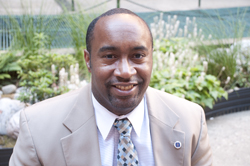Filed Under > Convocation
Probing the Nature of Giftedness
Doctoral student and award-winning principal Anael Alston believes excellence is a quality that can be attained
Anael Alston’s hooding as a Doctor of Education in Curriculum and Teaching, was his fourth prestigious award this year.
Alston is principal at the Robert M. Finley Middle School in Glen Cove, New York, which was one of 10 schools nationwide to receive the Breakthrough Schools Award from the MetLife Foundation and the National Association of Secondary School Principals (NASSP) in February.
On May 6, Alston received the New York State Principal of the Year award for middle school principals from the School Administrators Association of New York State and the NASSP, making him one of 50 finalists for the National Principal of the Year Award. On May 12 Alston received the Nassau County Board of Cooperative Educational Services’ Education Partner Award, which is given to the 14 most influential people for public education in Nassau County.
Alston, 40, has always stood out. In his early years of school, he and his brother were the only African American students at Yeshiva Rabbi David Leibowitz in Brooklyn. He took to heart the school’s message that, as a Jew, he belonged to an ancient tradition of scholarship and intellectual pursuit. “That kind of experience builds a sense of confidence and expectation,” he said. “It builds a sense of who you are in the larger context of the world. It ties you to a deep tradition.”
At home in his Bedford Stuyvesant neighborhood, things were less clear-cut. “I knew that I wasn’t necessarily the smartest person,” Alston recalled, “and that many people who were smarter than me were no longer alive or serving jail sentences.” His parents put a high premium on schooling, however, and pushed Alston to succeed. "They wanted me to have a clear sense of purpose...knowing my history and the expectations that come with a rich history. They were determined that my education would not be determined by my zip code and I would be successful in spite of any challenges that lay ahead. I drank the Kool-Aid; I believed it, to a certain extent.”
From the yeshiva, Alston entered the Satellite East Junior High School for the Gifted and Talented in Bedford Stuyvesant, where the seeds of his doctoral dissertation, written many years later, were planted. At Satellite East, most of the students had to demonstrate academic promise to get in, but 25 percent were taken from the bottom tier of applicants. And yet, with one-quarter of the study body not officially qualifying as “gifted,” the school had consistently sent up to 90 percent of its graduates to prestigious New York City high schools.
Satellite East has since been turned back into a traditional, zoned public school. But much later, as a history and physical education teacher at I.S. 59 in Queens and later at a few middle schools on Long Island, Alston began to think about what had made Satellite East so successful. What was “giftedness”? Was it a matter of a test score, or ability, or social capital? What role might race play in gifted programs? Was “giftedness” also about culture and expectations?
Wanting to answer these questions, Alston entered the top-ranked Curriculum and Teaching doctoral program at Teachers College. At TC he found James Borland, the Professor of Education whose academic and research interests fit squarely with Alston’s: the education of gifted students, especially economically disadvantaged gifted students, and conceptions of giftedness. Borland directed Alston’s dissertation, “Having Our Say: Thoughts, Perspectives and Perceptions of the Graduates of Satellite Junior High School for the Gifted and Talented.”
Of 59 alumni ages 30 to 39 who completed Alston’s online survey, 92 percent tied their success in life to their experience at Satellite East. Alston also interviewed former superintendents, principals and alumni, to find out what had made Satellite East so special when he was there. He discovered that, in addition to offering challenging academic work and support, the school built in “non-cognitive variables for success,” including emphasis on “discipline, self-control, and how middle- and upper middle-class people handle conflicts and problems.”
The notion of giftedness at Satellite East was “very fluid,” Alston says. “They put together a program of slightly exceptional students and got outstanding results, by having powerful teacher-student relationships in the areas of academic relevance, teacher caring and academic rigor.” School leaders also helped students build “social capital” by, for example, giving students opportunities to socialize with successful adults, to observe all the nuanced ways in which role models negotiated their social as well as professional lives.
These elements have shaped Alston’s professional life at Finley Middle School, located in a racially diverse, mixed-income city on Long Island. He runs it with “high expectations, clear expectations,” he says. “We constantly address and redress how to make everyone be included and deal with identifying and exploring academic gaps, not just within the student and racial population, but also in the county, state and world.
“Part of the nation’s challenge in public education is the outcomes of our big city school systems,” Alston said. “We’ve proven in Glen Cove that high poverty and diversity is not a sentence to mediocrity and failure.”
Published Thursday, May. 19, 2011
